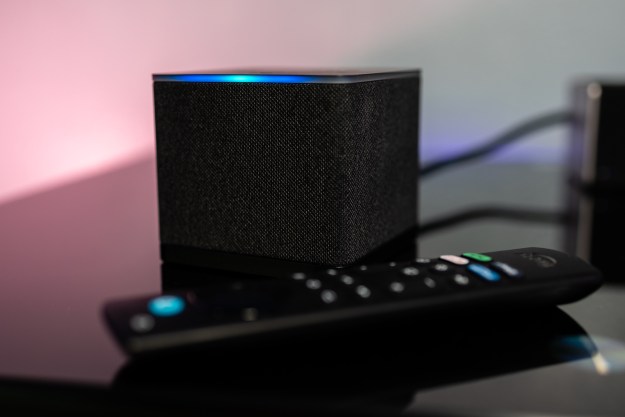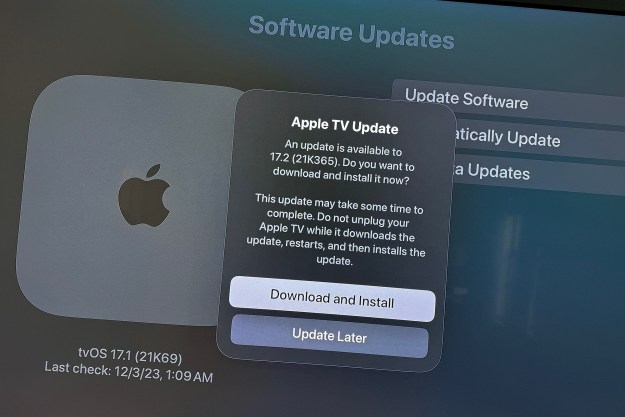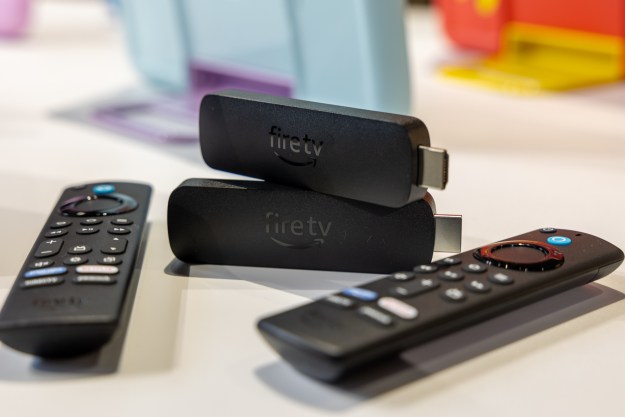
“The Amazon Fire TV Cube 2022 doesn't reinvent the wheel, but it does add some worthwhile features.”
- Directly supports cable/satellite set-top boxes
- Same great Alexa integration
- Fire TV OS is good, if busy
- Incrementally better overall
- Less simplicity with so many features
It must be hard to resist the temptation to reinvent the wheel. After all, the Fire TV Cube is the pinnacle of Fire TV devices. So somewhere in the bowels of Amazon’s hardware department, someone must have some pretty far-out ideas of what this little six-sided device could do.
But this third-generation Fire TV Cube (following models released in 2019 and 2018) is, at its simplest, an iterative product. It’s still part Amazon Echo, part Amazon Fire TV. It’s still got Fire TV OS beating at its heart and Alexa serving as its brain. Sure, it looks a tad different in this latest incarnation. It’s more powerful. It’s faster. And it does a few things it couldn’t do before.
But it’s still a Fire TV Cube. No more, no less. That’s a good thing for you, and for Amazon.
Fire TV Cube 2022 video review
What’s new in the Cube
There’s a lot that’s familiar in the new Fire TV Cube, so the stuff that’s new tends to stand out a little. Most obvious is the exterior. The vertical faces are now clad in cloth, just like the current-generation Amazon Echo speaker. That continuity is a good thing from a design standpoint. And while it may be a better collector of dust, it certainly won’t show fingerprints like the glossy Fire TV Cubes of yore.
The LED strip hasn’t changed. The buttons up top are mostly the same. Only four microphones are present (down from the previous six), but that’s not really anything to get worked up about as everything still works just fine.
Around the back is where you’ll find the meat of the changes. That starts first and foremost with the addition of an HDMI-in port. As the name would imply, you’re now able to run another device into the Fire TV Cube via HDMI and have your Cube control said device. The big-ticket examples here are cable and satellite set-top boxes. Of course, you could do that before (and still can) via infrared commands, the invisible rays that many remote controls use to get things done. The Cube still has IR support, as well as the external IR emitter if you need to control devices that are locked away in a drawer or cabinet.

The case for HDMI-in
So why HDMI? It’s simply better, Amazon says. And we’re mostly inclined to agree.
Plugging in a cable box (Cox Communications, if you must know) was simple enough. The hardest part there was that I had to drive five minutes to my parents’ house to find one. I did hit a temporary wall when I expected something to happen on its own once I plugged it in, so Amazon maybe could do a little better in explaining what needs to happen. But a few clicks through the input option set the provider and ZIP Code, and we were good to go. I could now tell Alexa to “Play ESPN on cable,” and the Cube would do exactly that.
In fact, it’s best not to think too hard about exactly what it’s doing, because the nomenclature gets a little confusing between the Cube and the television. Fire TV OS flashes a little notification that it’s changing inputs — but that’s really because it’s moving you between Fire TV OS and whatever device is coming in to the HDMI-in port. In this case, it was the cable box. The difference is that the television input isn’t changing at all.
Why does that matter? It keeps you, the user/viewer, inside the Fire TV experience. Or more inside it, anyway. It allows Fire TV OS to put overlays on top of whatever other device you’re using (possibly to the chagrin of those providers, but that’s another problem for another time). And we’re not just talking TV-related things. If you have cameras that work with Alexa, you’ll be able to see them on the screen without having to change from the cable box input to the Fire TV Cube input on the television, for example. That’s a pretty big use case, provided that you’ve got cameras that play nice.

Another reason for HDMI-in is that it allows Amazon to tinker with the picture itself. Resolution upscaling isn’t anything new. That’s where a lower-resolution picture is reworked for a higher-resolution display, so that 1080p content (or, gasp, 720p) doesn’t look quite so horrendous on a 4K television. And now that you’re able to run it through the Fire TV Cube, the operating system is able not just to increase the number of pixels making up the picture, but to improve on them as well. It’s the sort of thing that you’ll never notice without seeing it side by side with a standard picture, so we’re taking Amazon’s word for it a little bit. But it’s also the sort of thing that we’ve seen manufacturers of all sorts of devices do for years. Televisions do it. The Nvidia Shield TV device does it (and did a really good job of showing the difference).
And if you run your cable or satellite box through the Fire TV Cube, it can try to improve that picture, too.
The addition of HDMI-in is convenient if you need it, but useless if you don’t.
One more reason for HDMI-in, Amazon says, is that it allows deeper integration with set-top boxes. Infrared commands are dumb — the remotes don’t actually know the state of the box once the command has been issued. So if you turn it off with the remote, but back on with the power button on the box, the remote control doesn’t know the difference. Not so once HDMI is connected and the devices can actually communicate with each other.
And this sort of thing works even before you’ve turned the television on, thanks to “dual mode.” That’s been around in previous generations of Fire TV Cube, and it’s still here. It really just means the Cube works fine as an Amazon Echo device even when the TV is off, and that includes executing commands for watching things on the TV.
It’s also more than likely that all of this also gives Amazon even more data about what you’re using and how you’re using it. That’s not necessarily a bad thing, unless you’re the sort already unnerved by the sheer amount of information owned by Amazon and others. In any event, supported cable and satellite boxes are, at launch, from Altice Optimum/Suddenlink, AT&T DirecTV, AT&T U-verse, CenturyLink, Inc., Comcast Xfinity, Charter Spectrum, Cox, Dish Network, Frontier, Mediacom, and Verizon Fios.
Other changes
That’s all good stuff, and worthy of note. But it’s also entirely possible that it’s not something you’ll care about. More and more of us have gotten rid of cable and satellite TV in favor of streaming, whether for the price or the convenience. And in that case, the Fire TV Cube continues to be an excellent option as it has all the streaming apps you could possibly want or find on a competing device. In that case, the HDMI-in port is superfluous.
I also was a little nonplussed by the speed at which the Cube would flip from the Fire TV OS side of the equation into the Cox cable box. Switching from one streaming app to another isn’t all that fast on any hardware, Fire TV Cube or otherwise. I’m not sure why I expected the Cube to flip to the cable box faster than I could switch from ESPN+ to YouTube TV, but I did. And it’s definitely not the fastest process. Again, not a deal breaker. But it was an obvious annoyance.
So while HDMI-in is an important addition, it’s not the be-all and end-all of the new Fire TV Cube. The same goes for the other improvements, like a full-size USB-A port instead of a Micro USB. This allows you to add more storage, which is good because out of the box you’ll only have about 10 gigabytes of the original 16GB available. Just plug in a flash drive and you’re good to go. (It uses the standard expandable storage features of Android since Fire TV OS is still a fork of Android.)
Or, if you prefer, you could pop in a supported webcam for video calls, if that’s the sort of thing you don’t mind having in your living room all the time.
Amazon also has made an improvement when it comes to networking. There’s now a full Ethernet port on the back of the Cube, which is a welcome addition. First, because it means not having to run a dongle into that old Micro USB port (which, again, has been replaced by full USB-A). And second, because I’m all for plugging in whenever possible if only to remove the occasional wonkiness that comes with Wi-Fi.
That said, the port is 10/100 and not full gigabit, so you’re not necessarily going to blow wireless speeds out of the water here, especially since the new Cube also supports the Wi-Fi 6E standard, which as of the time of this writing is the latest and greatest. There’s also a pretty decent possibility that you’re current router doesn’t even support that standard yet, so maybe look at upgrading to a Wi-Fi 6E router. But it’s not a requirement — your current router likely works just fine.
As for why Amazon went with slower Ethernet? We’ve got the answer.

What’s missing
The Fire TV Cube is the best Fire TV device you can buy. But it doesn’t come with the best Alexa remote. That superlative is saved for the
Again, it’s not a deal breaker. But the Voice Remote Pro has features we’d like to see alongside the Cube, including backlit buttons, two customizable buttons for direct links to content or Alexa commands, and a “Remote Finder” feature that helps you find a lost remote.
The good news is that the Voice Remote Pro works with most modern Fire TV hardware, including the new Fire TV Cube. The bad news is it’s going to cost you $35 extra.
Building a better Cube
If you already have a perfectly functioning Fire TV Cube, you might well not need to upgrade anytime soon. (That said, the older ones are now three and four years behind, and eventually the software support is going to run out.) But if any of the new tentpole features — HDMI-in, better wireless networking, or webcam support — are of importance to you, now may be the time to take a look.
It’s all about the incremental upgrade, which isn’t a bad thing.
And the Fire TV Cube price remains competitive, insofar as the top shelf is concerned. At $140 retail, it’s squarely in the same conversation as the latest comparable Apple TV 4K ($150), though both are undercut by the Roku Ultra, which still retails at $100 before sale prices kick in.
What you really have here, though, is a Fire TV Cube that hasn’t looked to reinvent the wheel. Or, the cube, if you will. It still does the Alexa stuff brilliantly. It’s still a powerhouse of a Fire TV device, even if the user interface remains painfully busy at times. And now it’s including even more of what you might find in the typical living room, even if set-top boxes aren’t as prevalent as they once were.
The only real concern here is in simplicity. If you’re the sort on satellite or cable, are you looking to introduce a bit more complexity in that equation? If so, then fire away. The Cube will suit you well.
If you don’t need any of that newfangled HDMI stuff and really are a streamer at heart, just save yourself a good bit of cash and go with the also-excellent Fire TV Stick 4K Max.
Editors' Recommendations
- Best Amazon TV deals: Cheap TVs under $100
- YouTube TV just got even better on iPhones and iPads
- Sling TV adds arcade games on Fire TV and Android TV
- Amazon is trying to prove that AirPlay and Chromecast don’t matter
- Panasonic’s latest OLED TVs are the first with Amazon Fire TV built-in





